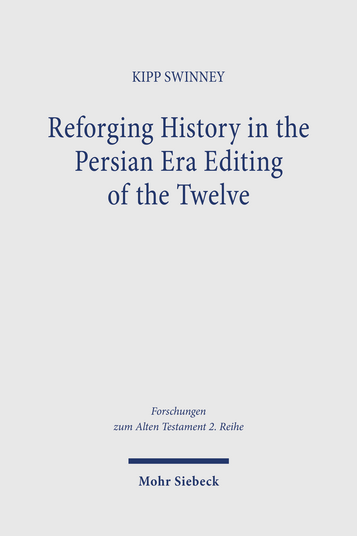Theology
Kipp Swinney
Reforging History in the Persian Era Editing of the Twelve
The Significance of the Motifs of the Divine Warrior, Chaoskampf, and Theophany for Shaping the Book of the Twelve
[Geschichtsschreibung in der persischen Redaktionszeit des Zwölfprophetenbuchs. Die Bedeutung der Motive des göttlichen Kriegers, des Chaoskampfes und der Theophanie für die Gestaltung des Zwölfprophetenbuchs.]
approx. 80,00 €
including VAT
including VAT
sewn paper
ISBN 978-3-16-163400-0
forthcoming
Also Available As:
Published in English.
In the Persian era, Judean editors of the Book of the Twelve incorporated new material and revised existing content in ways that reflected on the history from Assyria's fall to Persia's rise. Kipp Swinney argues that the Persian era editors of the Twelve embed a historiography that centralizes Yahweh's role in Judah's history by using the motifs of the divine warrior, Chaoskampf , and theophany. These motifs depict Yahweh's acting in history without human assistance, which enhanced Yahweh's legitimacy as king despite Babylon's destruction of Judah and Persia's ascendancy. Amos, Micah, Nahum, Habakkuk, and Zephaniah contain this embedded historiography and legitimizing agenda. Synthesizing developmental models of the Twelve with the tradition history of the motifs used, Swinney illuminates the Persian era shaping of the Book of the Twelve.Survey of contents
CHAPTER ONE: Introduction and History of ScholarshipLooking Forward – Definition of the Project – One Book or Twelve Books – History of Scholarship on the Diachronic Development of the Book of the Twelve – History of Scholarship on the Divine Warrior, Chaoskampf, and Theophany – Methodology – The Need for This Study
CHAPTER TWO: Sifting through the layers of the Twelve
The Formation of the Book of the Twelve – The Most Relevant Layers of the Twelve
CHAPTER THREE: Divine Warrior, Chaoskampf, and Theophany in the Persian Era. Reshaping of the Embedded Historiography of the Twelve—Nahum
The Literary-Historical Setting of Nahum – Divine Warrior, Chaoskampf, and Theophany in the Shaping of Nahum
CHAPTER FOUR: Divine Warrior, Chaoskampf, and Theophany in the Persian Era Reshaping of the Embedded Historiography of the Twelve—Habakkuk
The Literary-Historical Setting of the Book of Habakkuk – The Hymn of Habakkuk (Hab 3) – War and Woe: The Divine Warrior in Habakkuk's Woe Oracles – The Role of the Hymn and the Motifs of the Divine Warrior, Chaoskampf, and Theophany in the Shaping of Habakkuk – Nahum and Habakkuk and the Shaping of the Twelve
CHAPTER FIVE: Divine Warrior, Chaoskampf, and Theophany in the Persian Era Reshaping of the Embedded Historiography of the Twelve—The Book of the Four
Zephaniah and the Newly Minted Seventh Century Sub-Collection – Divine Warrior, Chaoskampf, and Theophany and the Reshaping of the Eighth Century Sub-Collection – The Book of the Four and the Evolving Book of the Twelve
CHAPTER SIX: The Twelve as a Response to the Shortcomings of Histories
Summary of Findings – Alternative Historiographies to the Long Sixth Century – The Contributions of This Study
